Pontiac Sunbird
The Pontiac Sunbird is a small car manufactured and marketed by Pontiac over two generations.
| Pontiac Sunbird | |
|---|---|
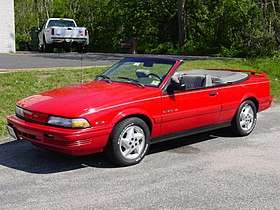 1993 Pontiac Sunbird Convertible | |
| Overview | |
| Manufacturer | General Motors |
| Production | 1975–1994 |
| Model years | 1976–1980 1982–1994 |
| Body and chassis | |
| Class | Subcompact (1976–1980) Compact (1982–1994) |
| Chronology | |
| Successor | Pontiac Sunfire |
The first generation was marketed as a subcompact hatchback, wagon and coupe (1976–1980) — as a badge engineered variant of the Chevrolet Monza, which was based on the Chevrolet Vega.
The second generation (1982–1994) was marketed as notchback coupé, sedan, hatchback, station wagon, and convertible as a rebadged variant of General Motors' J-cars and was manufactured alongside the Cadillac Cimarron, Buick Skyhawk, Oldsmobile Firenza, and Chevrolet Cavalier at GM's South Gate Assembly and Janesville Assembly plants.
The Sunbird nameplate ran for 18 years (with a hiatus during the 1981 and 1982 model years, as there was no 1981 model and the 1982 model was marketed as the J2000) and was replaced in 1995 by the Pontiac Sunfire.
First generation (1976–1980)
| First generation | |
|---|---|
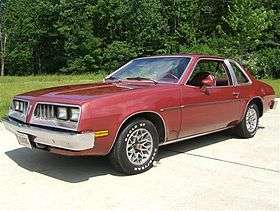 1978 Pontiac Sunbird Sport coupe | |
| Overview | |
| Production | 1975–1980 |
| Model years | 1976–1980 |
| Assembly | Lordstown Assembly, United States South Gate Assembly, United States Sainte-Thérèse Assembly, Canada |
| Body and chassis | |
| Body style | 2-door coupe 2-door hatchback 2-door station wagon |
| Layout | FR layout |
| Platform | H-body |
| Related | Buick Skyhawk Oldsmobile Starfire Pontiac Astre Chevrolet Monza Chevrolet Vega |
| Powertrain | |
| Engine | 140 cu in (2.3 L) 2300 I4 151 cu in (2.5 L) Iron Duke I4 231 cu in (3.8 L) Buick V6 305 cu in (5.0 L) Chevrolet V8 |
| Dimensions | |
| Wheelbase | 97.0 in (2,460 mm) |
| Length | 179.2 in (4,550 mm) coupe/hatchback 178.0 in (4,520 mm) Wagon |
| Height | 49.6 in (1,260 mm) coupe/Hatchback 51.8 in (1,320 mm) Wagon |
| Chronology | |
| Predecessor | Chevrolet Vega |
The first-generation Pontiac Sunbird is a subcompact[1], four-passenger automobile introduced in September 1975, and produced for the 1976 through 1980 model years. The first-generation Sunbird is a badge engineered version of the Chevrolet Monza which was derived from the Chevrolet Vega.[2] Built on the H-body platform, its intended competitors were other small sporty two-door vehicles including the Toyota Celica, Datsun 200SX, Mercury Capri, and the Ford Mustang II. It did not share any mechanical relation to the Holden LX Sunbird.
Overview
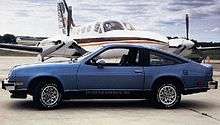
The Sunbird has a 97.0-inch (2,460 mm) wheelbase and a 65.4-inch (1,660 mm) width. The first generation Sunbird is a rear-wheel-drive vehicle with a live rear axle design. The standard engine is the Vega aluminum-block 140 CID inline-four. Equipped with a single-barrel carburetor, it generates a peak power output of 78 horsepower (58 kW) at 4,200 rpm. the standard transmission was a four-speed manual, with a five-speed manual and three-speed automatic transmission options. This engine was also available with a two-barrel carburetor that increased peak power to 87 horsepower (65 kW) at 4,400 rpm, as well as Buick's 3.8 L (231 cid) V6 engine rated at 110 horsepower (82 kW) at 4,000 rpm. The front suspension is short and long control arms with coil springs, and anti-roll bar; the rear suspension is a torque-arm design with coil springs and an anti-roll bar. Variable-ratio power steering was standard of a recirculating ball type. The brake system features front disc brakes with vented rotors, and rear drum brakes. Power-assist was standard.
Model Year changes
When the Sunbird was introduced for 1976, it was only available in a notchback coupe body-style shared with the Chevrolet Monza Towne Coupe. For 1977, the hatchback body-style was added. All Sunbirds had a new standard engine: Pontiac's 151 CID "Iron Duke" inline four-cylinder engine using a two-barrel Holley carburetor and generating 90 horsepower (67 kW) at 4,400 rpm. A Formula option was available on coupe, wagon, and hatchback. It includes the handling package, a chrome valve cover, three-piece spoiler, T/A steering wheel, and special body decals. EPA gas mileage rating was 28 MPG city and 34 MPG highway with the five-speed manual, exceptionally good for that era.
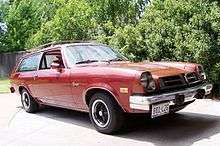
For 1978 and 1979, the station wagon from the otherwise discontinued Astre series was added to the Sunbird line. They continued to use the same front fascia as the Astre with Sunbird badging. The 2.3 L engine was simultaneously discontinued.
For the 1978 and 1979 model years, the Chevrolet 5.0 L (305 cid) V8 engine was made optional in the notchback and hatchback (RPO LG3, 481 for 1978 and 986 for 1979), while the Sunbird Safari wagon continued for its final year with a revised vertical styled grill. The 1978 and 1979 engine options included the 305 cu in (5.0 L) V8, 3.8L V6 and a 2.5L I4. Body options included the Firebird Redbird package, Sunbird Formula package, and sunroof. Air conditioning was available as was four-speed manual transmission or three-speed automatic transmission.
1980 was the final production year of the H-bodied Sunbird. By this time the wagon body style and the optional V8 engine were discontinued. The year featured an unusually long production run in order to provide sufficient inventory to carry dealers into the 1981 model year, in anticipation of the Sunbird's replacement.
A total 479,967 H-body Sunbirds were produced in five model years.
Second generation (1982–1988)
| Second generation | |
|---|---|
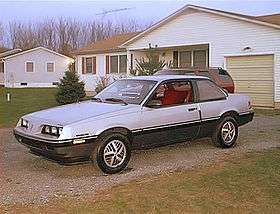 1986 Pontiac Sunbird coupe | |
| Overview | |
| Also called | J2000 (1982) 2000 (1983) 2000 Sunbird (1983–1984) |
| Production | 1981–1988 |
| Model years | 1982–1988 |
| Assembly | United States: Lordstown, Ohio (Lordstown Assembly) South Gate, California (South Gate Assembly) Mexico: Ramos Arizpe (Ramos Arizpe Assembly) |
| Body and chassis | |
| Body style |
|
| Layout | Transverse front-engine, front-wheel drive |
| Platform | J-body |
| Related | Cadillac Cimarron Buick Skyhawk Oldsmobile Firenza Chevrolet Cavalier |
| Powertrain | |
| Engine | |
| Transmission | 4/5-speed manual 3-speed automatic |
| Dimensions | |
| Wheelbase | 101.2 in (2,570 mm) |
| Length | 169.5 in (4,310 mm) |
| Width | 66.3 in (1,680 mm) |
| Height | 53.6 in (1,360 mm) |
For 1982, the rear-wheel-drive Sunbird was replaced by a new front-wheel-drive compact called the J2000. Appearing as a sedan, coupe, wagon or hatchback, the J2000 was powered by a carbureted, overhead valve cast-iron 1.8-litre four-cylinder engine. Power was 88 hp (66 kW).[3] During the year, this engine was joined by a new 1.8-litre four, a single overhead-cam unit with an aluminum head imported from GM of Brazil. This engine used throttle-body electronic fuel injection, in contrast to the carburetor that was used in the previous engine, making 84 hp (63 kW). It was initially only available in conjunction with the automatic transmission. The J2000 shared GM's internationally used J-Body platform with the Chevrolet Cavalier, Oldsmobile Firenza, Buick Skyhawk, and Cadillac Cimarron in North America.
For 1983, the J prefix was dropped. This was in an effort to market the J2000 as a smaller version of the Pontiac 6000, which had a similar appearance. A five-speed manual was newly optional. The standard engine was replaced by the fuel injected Brazilian engine, while a stroked 2-litre fuel injected version of the overhead-valve 1.8 became the optional engine, producing 88 hp (66 kW).[4] A convertible called the 2000 Sunbird was also new for 1983.
1984 brought a new front fascia for a smoother, less angular look. The lineup was renamed 2000 Sunbird, a title used only on the convertible the previous year. A new turbocharged four-cylinder was available. Based on the standard 1.8L inline-four that powered other 2000 Sunbirds, it used multi-port fuel injection, for a total output of 150 hp (110 kW). This engine was popular, and more powerful than many V6 engines in competing brands.
1985 was a carryover year, except for the 2000 prefix being dropped.
For 1986, the optional 2-litre four was discontinued.[5] A GT model arrived at the top of the lineup. It featured fender flares, hidden headlamps, and the turbo engine standard. It was available in sedan, coupe, hatchback, or convertible.[5] The GT sedan is very rare, with fewer than 5,000 sold. The GT convertible is the rarest variant, with fewer than 1,300 sold.
.jpg)
A redesigned gauge cluster and new engines were introduced for the 1987 model year. The gauge cluster featured different graphics, and a 120 mph (190 km/h) speedometer on turbo equipped models, where 1984-1986 turbo models had an 85 mph (137 km/h) speedometer. The new engines were "punched out" versions of the 1.8L, displacing 2.0L. The base engine still used throttle-body injection, for a new total of 96 hp (72 kW), and the turbo still used port-injection, for a new total of 165 hp (123 kW). Also, the convertible could only be ordered in GT trim. The rear fascia was redesigned in 1988, and the four-speed manual was discontinued. 1989 was the last year for the convertible GT, with the Turbo engine option dropped after 1990.
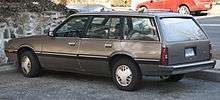
Facelift 1988½–1994
| Third generation | |
|---|---|
 1989–'94 Pontiac Sunbird Coupe | |
| Overview | |
| Also called | Chevrolet Cavalier (Mexico) Pontiac GT |
| Production | 1988–1994 |
| Model years | 1988½–1994 |
| Assembly | Lordstown, Ohio, United States Ramos Arizpe, Mexico |
| Body and chassis | |
| Body style | 2-door convertible 2-door coupe 4-door sedan 4-door station wagon |
| Layout | Transverse front-engine, front-wheel drive |
| Platform | J-body |
| Related | Buick Skyhawk Cadillac Cimarron Chevrolet Cavalier |
| Powertrain | |
| Engine | |
| Transmission | 3-speed automatic 5-speed manual |
| Dimensions | |
| Wheelbase | 101.3 in (2,570 mm) (1991–92) 101.2 in (2,570 mm) (1989–90) 103.4 in (2,630 mm) (1993–94) |
| Length | 180.7 in (4,590 mm) (1991–94) 181.3 in (4,610 mm) (1989–90) |
| Width | 66.3 in (1,680 mm) |
| Height |
|
| Curb weight | 2,696–2,745 lb (1,223–1,245 kg)[6] |

Production under the Sunbird name was continued until 1994. The trim levels on both the sedan and coupe were base, SE and GT. The Sunbird SE coupe, SE sedan and the GT coupe and convertible had partially concealed headlamps, a feature that originally appeared on the Isuzu Impulse, that gave the appearance of "raised eyebrows" when the headlights were on. The base model initially had the 1984-87 front fascia with exposed sealed beam headlamps. The engines were both the carryover 2.0L 96 hp (72 kW) I4 and the turbocharged 165 horsepower 2.0L four. GM discontinued the Safari name on the Sunbird station wagon models.
In 1989, the base model received a smoother, more aerodynamic front fascia and the model was renamed "LE". An LE coupe joined the lineup also, with the same features as the LE sedan, but for a slightly lower price. The SE sedan was discontinued. In all models, however, a new dashboard was added. It somewhat resembled that of the larger Pontiac Grand Prix, redesigned for 1988. The most notable change from the previous dashboard is the placement of the stereo. A redesigned AM/FM stereo unit was placed high in the dash. If a cassette player or compact disc player (new for 1989) were ordered, they were relocated at the bottom of the dash.
For 1990, the GT and SE coupes received a smoother front fascia with hidden headlamps. The GT convertible is discontinued, replaced by a turbocharged LE convertible, which also retains the GT suspension and steering. In all models, GM's passive seatbelt system was introduced. The seatbelts were mounted on the doors and would stretch out when latched.

The turbo four was deleted for 1991, replaced by the Cavalier's 3.1L V6. With Multi-Port Fuel Injection, it produced 140 hp (100 kW) at 5200 rpm, and 185 lb⋅ft (251 N⋅m) of torque at 4800 rpm. Although there was less horsepower under the hood, power came much quicker and smoother than the Turbo, with about the same fuel economy. The V6 engine could be ordered in any model, save the new-for 1991 base value model. The SE coupe received the LE coupe front fascia, but the GT's fascia could still be ordered with a sport package exclusive to SE coupes.
The largest change for the 1992 model year was a revision of the base engine. The 2.0 L SOHC TBI four was replaced with the 2.0 L SOHC MPFI four resulting in a fuel economy increase and power increase. Power was increased from 96 hp (72 kW) to 110 hp (82 kW) and torque increased from 118 to 124 lb⋅ft (168 N⋅m). NOTE: The intake manifold casting is a bit thick and responds well to port matching the head with a stock felpro gasket. An SE sedan was once again available, and the base models were dropped and the convertible moved from LE to SE. The only change for 1993 was the addition of a glass rear window with defroster on convertibles.
As the Sunbird came to a close, the trims were pared down. The SE sedan, SE convertible and GT coupe were dropped for 1994. The LE sedan, LE coupe and LE convertible (moved from SE to LE), and SE coupe stood pat for one more year. The SE coupe was essentially the 1993 GT coupe with a lower price.
Most Sunbirds were built in Lordstown, Ohio and Ramos Arizpe, Mexico. The last one rolled off the assembly line on April 27, 1994. The Sunbird was replaced by the Pontiac Sunfire in 1995.
GT
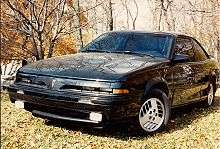
The Sunbird GT model was introduced in 1986 as a coupe, sedan, convertible or fastback hatch with a 1.8 L turbocharged inline-four engine of the Family II range (LA5) as standard equipment. The 150 hp (112 kW) 1.8-liter turbo engine had been available since 1984. In 1987 the engine was upgraded to the 165 hp (123 kW) LT3.
All GTs featured semi-concealed headlamps and fender flares and "Turbo GT" badges replacing "Sunbird" badges. However, on the turbo delete cars the "Sunbird" badges were replaced by "Sunbird GT" badges. The sedan was dropped for 1988 and the interior for the coupe was redesigned for 1989. The convertible was dropped for 1990 and the turbo followed in 1991. Replacing the turbo four-cylinder for 1991 was GM's 3.1-liter V6 that produced 140 hp (104 kW), but was quieter and smoother than the turbo. After 1993, the GT coupe became the SE coupe when the lineup was consolidated prior to the new model arriving for 1995.
Sunbird in Mexico
From 1988 to 1992, the US Chevrolet Cavalier was sold in the Mexican market as a replacement for the Chevrolet Citation in the compact segment, due to the dismissal of the last one in 1987. The Sunbird was first sold in Mexico in 1992 as a 1993 model; prior to this, the Sunbird had been badged as the "new" Chevrolet Cavalier, seeming like an exterior redesign for the compact, but preserving the same interior as the "previous" model, also replacing the Pontiac badges with Chevrolet bowties. A unique characteristic for the Mexican version was the offering of the second generation LB6 MPFI 2.8L V6 engine as the single powerplant for either base and top models, either attached to a 5-speed manual or a 3-speed automatic transmission.
The Pontiac Sunbird GT was also renamed, being sold as the Chevrolet Cavalier Z24, and having the LH0 3.1L MPFI V6 as the standard engine, either with the same 5-speed manual or 3-speed automatic powertrains used by the regular models. Both versions of Sunbird labeled as Cavaliers were sold until 1995, when the new generation of the Chevrolet Cavalier, and the new replacement for the Sunbird, the Pontiac Sunfire, were introduced both as separated models in Mexico.
Related models
In Europe the J200 shape (the name given by GM to this platform) was used in production of the Vauxhall Cavalier Mk II (U.K.) and Opel Ascona (Germany and other European countries). The European models received different styling from North American versions. The sports coupé variants were not marketed in Europe although it did appear in Latin America as the "Chevrolet Monza." Similar revisions were made for the J200 platform in the Australian market where it was named the "Holden Camira" - although there had also been an unrelated Holden Sunbird offered from 1976 until 1980. In 1989 the Cavalier and Ascona J200 was replaced with a remodelled version known as the Vectra Mk1 in Europe and the UK.
Engines
The 1982–1994 Sunbird came with one of these engines:
- 1982: 1.8 L L46 carbureted OHV I4
- 1982–1986: 1.8 L LH8 TBI SOHC I4
- 1983–1985: 2.0 L LQ5 TBI OHV I4
- 1984–1986: 1.8 L LA5 turbocharged MPFI SOHC I4
- 1987–1991: 2.0 L LT2 TBI SOHC I4
- 1987–1990: 2.0 L LT3 turbocharged MPFI SOHC I4
- 1991–1994: 3.1 L LH0 MPFI OHV V6
- 1992–1994: 2.0 L LE4 MPFI SOHC I4
See also
- Chevrolet Vega: Vega variants-Pontiac Sunbird Safari Wagon
- General Motors H-platform
References
- http://www.oldcarbrochures.org/United%20States/Pontiac/1976%20Pontiac/1976-Pontiac-Full-Line-Brochure/slides/1976_Pontiac_Full_Line-03.html
- h-body.org
- Gunnell, John; Kowalke, Ron (2012). Standard Catalog of Pontiac, 1926-2002 (2nd ed.). Iola, WI: Krause Publications. pp. 178–180. ISBN 978-1-4402-3234-3.
- Gunnell and Kowalke (2012), p. 185
- Gunnell and Kowalke (2012), p. 215
- "Pontiac Sunbird". Retrieved 12 August 2014.
Sources
- Flammang, James M. & Kowlake, Ron, Standard Catalog of American Cars: 1976–1999, 3rd Edition (Iola, WI: Krause Publications, 1999)
- Gunnell, John, Standard Catalog of American Cars: 1946–1975, Revised 4th Edition (Iola, WI: Krause Publications, 2002)